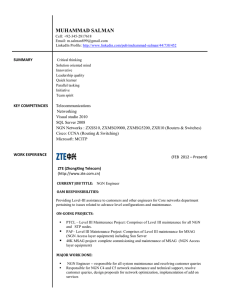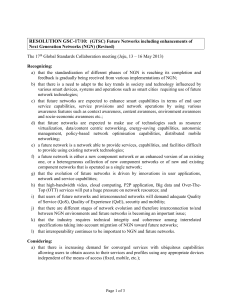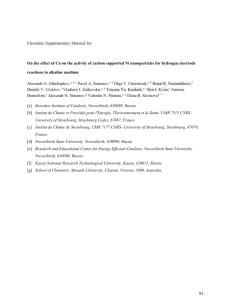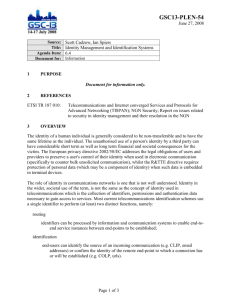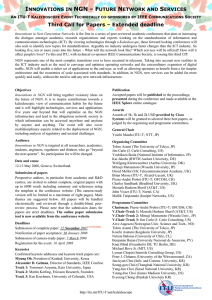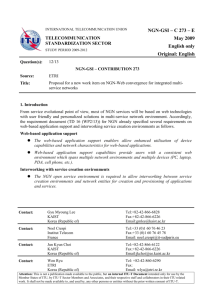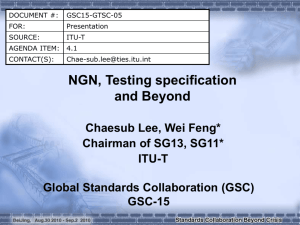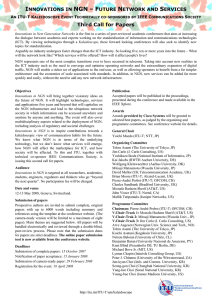The Role of Trichomes in Mn accumulation and toxicity in the Ni
advertisement
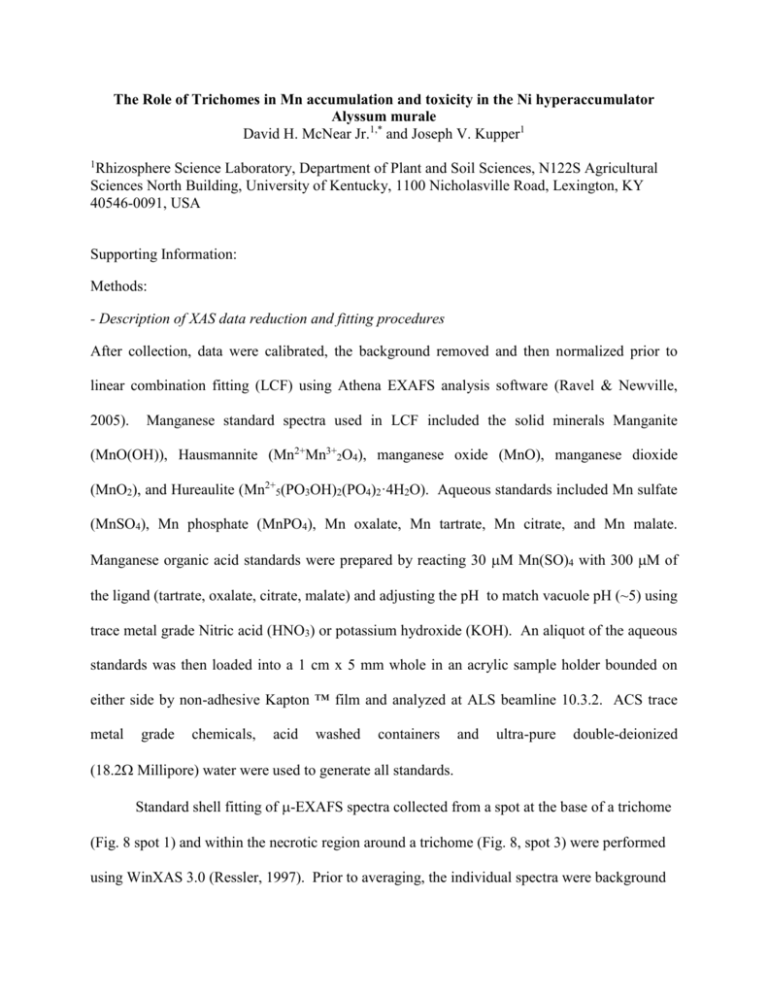
The Role of Trichomes in Mn accumulation and toxicity in the Ni hyperaccumulator Alyssum murale David H. McNear Jr.1,* and Joseph V. Kupper1 1 Rhizosphere Science Laboratory, Department of Plant and Soil Sciences, N122S Agricultural Sciences North Building, University of Kentucky, 1100 Nicholasville Road, Lexington, KY 40546-0091, USA Supporting Information: Methods: - Description of XAS data reduction and fitting procedures After collection, data were calibrated, the background removed and then normalized prior to linear combination fitting (LCF) using Athena EXAFS analysis software (Ravel & Newville, 2005). Manganese standard spectra used in LCF included the solid minerals Manganite (MnO(OH)), Hausmannite (Mn2+Mn3+2O4), manganese oxide (MnO), manganese dioxide (MnO2), and Hureaulite (Mn2+5(PO3OH)2(PO4)2·4H2O). Aqueous standards included Mn sulfate (MnSO4), Mn phosphate (MnPO4), Mn oxalate, Mn tartrate, Mn citrate, and Mn malate. Manganese organic acid standards were prepared by reacting 30 M Mn(SO)4 with 300 M of the ligand (tartrate, oxalate, citrate, malate) and adjusting the pH to match vacuole pH (~5) using trace metal grade Nitric acid (HNO3) or potassium hydroxide (KOH). An aliquot of the aqueous standards was then loaded into a 1 cm x 5 mm whole in an acrylic sample holder bounded on either side by non-adhesive Kapton ™ film and analyzed at ALS beamline 10.3.2. ACS trace metal grade chemicals, acid washed containers and ultra-pure double-deionized (18.2Millipore) water were used to generate all standards. Standard shell fitting of -EXAFS spectra collected from a spot at the base of a trichome (Fig. 8 spot 1) and within the necrotic region around a trichome (Fig. 8, spot 3) were performed using WinXAS 3.0 (Ressler, 1997). Prior to averaging, the individual spectra were background corrected and normalized. Background subtraction was performed by fitting a linear polynomial to the pre-edge region between 150 and 50 eV below the Mn K-edge. The edge jump was normalized to unity by fitting a linear polynomial between 100 and 500 eV above the Mn Kedge. The threshold energy (Eo) was determined by selecting the root of the second derivative through the absorption edge of the differentiated spectra, and used to convert the spectra from energy to k-space (photoelectron wave vector (Å-1). A cubic spline function with ≤ 7 knots was then used to remove the contribution to the spectrum resulting from atomic absorption in the absence of backscattering contributions. This step generated the EXAFS function (χ (k), which was then weighted by k3, to compensate for dampening of the EXAFS amplitude with increasing k. The k3(k)-spectra were then Fourier transformed using a Bessel window with a smoothing parameter of 3 to reduce artifacts due to the finite Fourier filtering range used. This step produced radial structural functions (RSF) which were not corrected for phase shift. The first two major shells (when present) below 3.7 Å-1 were individually selected, backtransformed and fit using a nonlinear least squares fitting (NLLSF) approach and theoretical scattering paths generated using Artemis and FEFF 7.02 software packages (Zabinsky et al., 1995; Ravel & Newville, 2005). The Mn-O and Mn-P phase and amplitude functions were generated using the refined crystal structure for Hurealite (Menchett.S & Sabelli, 1973). The parameters obtained fitting the individual shells were then refined using a multi-shell fit over the entire spectra in k (2.43-11.66 Å-1) and R (0.56-3.71 Å) spaces. The energy shift parameters (Eo) were set equal for all paths and the amplitude reduction factor (So2) was fixed at 0.80. The number of variables used in the fits were always less than 18, the number of independent points (NIP) calculated as Npts = 2∆k∆R/π. Errors in the bond distance (R) are estimated to be R ± 0.02 Å and R ± 0.05 Å, and errors for the coordination number (CN) are estimated to be CN ± 20% and CN ± 40%, for the first (Mn-O) and second shells (Mn-P), respectively based on the fit statistics provided by WinXAS. Menchett.S, Sabelli C. 1973. Crystal-Structure of Hureaulite, Mn5(Hopo3)2(Po4)2(H2o)4. Acta Crystallographica Section B-Structural Science 29(Nov15): 2541-2548. Ravel B, Newville M. 2005. ATHENA, ARTEMIS, HEPHAESTUS: data analysis for X-ray absorption spectroscopy using IFEFFIT. Journal of Synchrotron Radiation 12: 537-541. Zabinsky SI, Rehr JJ, Ankudinov A, Albers RC, Eller MJ. 1995. MULTIPLE-SCATTERING CALCULATIONS OF X-RAY-ABSORPTION SPECTRA. Physical Review B 52(4): 2995-3009. Table S1: Tissue concentration of 5 different elements in leaf (L), stem (S) and root (R) samples from control plants grown in optimal (control) chelate buffered nutrient solutions and those supplemented with varying ratios of Ni and Mn. Element concentration in tissue (g g -1 ± SD) Plant Part L S R g DW plant-1 Ni0/Mn5 L S R Ni0/Mn10 Treatment (m) F b Ni 15.10 ± 0.08 12.14 ± 3.26 0.88 ± 0.11 C c b Ca 26496.45 ± 1939.70 A 11147.85 ± 2911.48 a 1753.04 ± 85.43 ab Fe 81.21 ± 3.88 44.22 ± 5.37 34.25 ± 8.24 0.7006 0.3168 0.2181 382.62 ± 10.96 E 41.91 ± 3.18 b 167.82 ± 72.10 b 20.89 ± 0.90 2.83 ± 0.54 0.65 ± 0.05 C c b 25184.09 ± 3293.90 AB 1630.96 ± 515.44 c 1745.39 ± 217.40 ab 77.90 ± 6.06 BCD 4.86 ± 0.61 e 54.75 ± 7.44 b 72.59 ± 0.18 BCD 41.68 ± 2.24 e 75.85 ± 18.65 d L S R 1.0354 0.4622 0.3416 565.39 ± 3.87 D 57.21 ± 18.78 b 184.27 ± 44.68 b 15.13 ± 0.19 2.01 ± 0.50 0.73 ± 0.49 C c b 23660.52 ± 711.74 AB 2344.35 ± 907.82 c 1649.00 ± 316.89 ab 84.53 ± 1.11 7.25 ± 0.49 31.50 ± 0.37 BC e b 87.32 ± 0.25 36.61 ± 3.07 48.22 ± 2.51 Ni0/Mn20 L S R 0.4277 0.1972 0.1489 1325.66 ± 46.81 C 89.02 ± 14.57 b 308.33 ± 41.74 b 21.66 ± 0.50 3.18 ± 0.79 0.64 ± 0.02 C c b 26227.06 ± 818.32 A 2436.17 ± 239.66 c 1498.40 ± 167.41 ab 115.20 ± 4.30 8.70 ± 0.07 39.65 ± 0.58 A e b 131.03 ± 12.07 A 58.42 ± 4.09 de 140.62 ± 3.03 bd Ni0/Mn30 L S R 0.2519 0.1021 0.0949 1420.59 ± 6.85 BC 541.33 ± 5.23 a 865.39 ± 403.84 a 13.85 ± 0.50 10.18 ± 0.79 2.78 ± 0.99 C c b 15822.61 ± 523.14 CD 4005.93 ± 1284.17 bc 2050.23 ± 13.39 a 75.91 ± 3.48 30.92 ± 3.29 112 ± 16.46 BC c a 60.57 ± 1.42 CDE 124.27 ± 0.27 bc 130.82 ± 32.58 bd Ni0/Mn50 L S R 0.1524 0.0645 0.0527 1868.79 ± 27.85 A 675.69 ± 8.13 a 270.91 ± 0.73 b 41.79 ± 1.05 31.08 ± 1.46 1.39 ± 0.05 C c b 22547.02 ± 1903.77 AB 8595.74 ± 1188.51 ab 1700.79 ± 84.94 ab 92.56 ± 2.61 46.23 ± 1.69 46.43 ± 3.05 B a b 79.49 ± 1.33 182.40 ± 2.55 214.63 ± 1.80 BC a ab Ni50/Mn50 L S R 0.1408 0.0664 0.0381 1501.98 ± 1.31 B 596.47 ± 8.91 a 160.13 ± 22.02 b 5536.58 ± 118.98 A 5564.86 ± 454.90 a 239.23 ± 24.80 a 19305.75 ± 1619.97 BC 9348.52 ± 550.58 a 1706.88 ± 380.90 a 73.35 ± 1.65 35.91 ± 2.41 49.19 ± 6.68 CD bc b 46.51 ± 3.96 123.54 ± 11.84 349.94 ± 69.39 E bc a Ni50/Mn0 L S R 0.3200 0.1362 0.1036 7582.14 ± 156.13 B 6812.88 ± 980.35 b 1429.68 ± 3.26 10071.30 ± 282.33 1444.12 ± 93.79 1154.23 ± 81.88 control 0.3940 0.1621 0.1051 Mn 68.55 ± 1.39 17.14 ± 4.09 3.73 ± 0.40 63.98 ± 0.73 14.24 ± 2.87 18.34 ± 1.34 F b D c b BC ab b 102.16 ± 0.93 D 31.68 ± 0.73 d 177.75 ± 15.65 a Zn 53.87 ± 0.38 DE 136.83 ± 3.83 b 148.63 ± 39.74 bd B e d 68.12 ± 1.52 E 183.41 ± 6.21 cd 504.26 ± 53.98 ab Tissue concentrations represent the means ± stdev from an average of ten plants per treatment. Levels for leaf (L), stem (S) and root (R) metal concentraitons within a column not connected by same symbol are significantly different as determined by Tukey's HSD ( P <0.05) 1.498 1.8 1.6 Shoot Weight 1.017 1.2 Root Weight 0.456 0.104 0.038 0.053 0.095 0.217 0.342 0.149 0.2 0.105 0.4 0.218 0.6 0.207 0.354 0.8 0.625 1.0 0.556 Weight (plant-1) 1.4 0.0 control Ni0/Mn5 Ni0/Mn10 Ni0/Mn20 Ni0/Mn30 Ni0/Mn50 Ni50/Mn50 Ni50/Mn0 treatment Figure S1: Relationship between Mn treatment and shoot (gray bars) and root (black bars) weight (Cntrl = 0.2 M Mn). Error bars represent the standard error of the mean plant weight across all treatments. 16.0 14.4 14.0 Tf (shhot :root) 12.0 10.0 7.6 8.0 5.6 6.0 4.0 1.6 2.0 2.2 3.0 2.7 1.3 0.0 control Ni0/Mn5 Ni0/Mn10 Ni0/Mn20 Ni0/Mn30 Ni0/Mn50 Ni50/Mn50 Ni50/Mn0 Treatment Figure S2: Manganese (Mn) translocation factor (Tf) defined as the ratio of Mn concentration (g g-1) in the shoot vs. that in the root. Mn Citrate Mn Malate Mn Tartrate Normalized Absorbance MnSO4 Heaurulite Mn Oxalate Manganite Hausmannite MnPP MnO2poly MnO2 Pyrolusite 6.52 6.54 6.56 6.58 keV 6.6 6.62 Figure S3: XANES spectra of Mn standards used in linear combination fitting of -XANES spectra from A. murale in Figure 8
